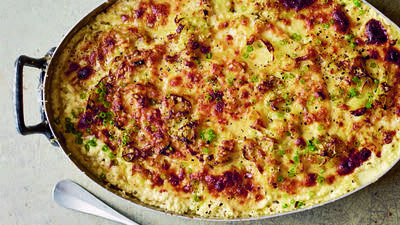Flash-roasting salmon in a very hot oven is the simplest way I know to cook a flavorful fillet. If I'm starting with soup or a salad, I assume that a pound of thick boneless salmon fillet will feed four when served with a starch and a green vegetable. If there is no first course, then I allow ½ pound per person.
You may not be familiar with saba. It's used much liked aged balsamic vinegar, although it is made from cooked-down (rather than aged) grape must. Available at specialty food shops and from purveyors such as Corti Brothers, saba costs much less than real aged balsamico (and has a very different quality). It's a nice item to have in your pantry.
I like saba's fruity flavor in contrast with the fattiness of the salmon; it acts much like lemon with chicken or orange with duck. If you don't have any saba, just drizzle fresh lemon juice and a great fruity and fragrant olive oil over the roasted salmon.
Ingredients
1 tablespoon fruity and fragrant olive oil
1 to 2 pounds salmon fillet
Coarse sea salt and freshly ground black pepper, to taste
1/4 cup saba
Instructions
Preheat the oven to 500ºF. Put a cast-iron or other ovenproof metal frying pan in the oven to preheat at the same time, about 10 minutes.
When the pan it hot, pour a very little of the olive oil into the pan (it should immediately thin), tipping the pan to coat the bottom with a thin film of oil.
Carefully place the salmon fillet in the pan, skin side down (cut it into serving-size pieces if necessary to make the fish fit in the pan.) The oil should sizzle when you add the fish. If it doesn't it's not hot enough. Carefully, using your hands or a pastry brush, smooth the rest of the oil over the top of the fish.
Roast the fish in the oven for 12 to 15 minutes, depending on the thickness of the fillet. The fish is done when the flesh is opaque and when it flakes very slightly when prodded with a fork. Remove it immediately from the pan and place it on a serving platter or plates. Season with salt and pepper to taste. Sprinkle with the saba, or pass it at the table. Serve at once.
Pans for flash-roasting fish
I started flash-roasting fish after reading Theresa Laursen's cookbook From Bangkok to Bali. Her recipe for Asian-flavored flash-roasted salmon got me started, and now I often use her technique. I used to use a large cast-iron frying pan, and any good heavy metal pan—whether iron, aluminum, or steel—will work as long as the pan has a metal (not plastic or nylon) handle that can take intense heat and preheating. I now use an oval frying pan made by Calphalon (they call it a fajita pan). This pan is lighter on the wrist, and because the oval surface is perpendicular to the handle, it can hold a whole fish and still fit in a standard 27-inch oven. The dark hard-anodized aluminum conducts heat extremely well, needs little preheating time to come to temperature, and gives the fish a great crust. Note that any pan with a non-stick finish is a poor choice for this method because nonstick coatings are not made for high heat.
Adapted from The Flavors of Olive Oil: A Tasting Guide and Cookbook by Deborah Krasner (Simon & Schuster, 2002). Copyright 2002 by Deborah Krasner.
Before you go...
Each week, The Splendid Table brings you stories that expand your world view, inspire you to try something new, and show how food connects us all. We rely on your generous support. For as little as $5 a month, you can have a lasting impact on The Splendid Table. And, when you donate, you’ll join a community of like-minded individuals who love good food, good conversation, and kitchen companionship. Show your love for The Splendid Table with a gift today.
Thank you for your support.
Donate today for as little as $5.00 a month. Your gift only takes a few minutes and has a lasting impact on The Splendid Table and you'll be welcomed into The Splendid Table Co-op.



